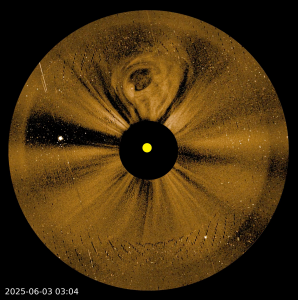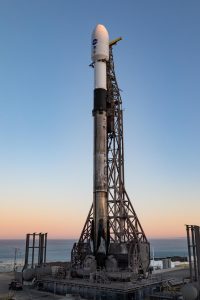BEAM: Breakthroughs – How Andover Corporation’s Advanced Coating Technology Powers NASA’s PUNCH Mission
In the demanding realm of space-based solar observation, precision optical components must withstand extreme conditions while delivering uncompromising performance. NASA's recently launched PUNCH (Polarimeter to UNify the Corona and Heliosphere) mission exemplifies this challenge, requiring specialized optical filters and coatings capable of operating in the harsh environment of space while providing critical data about our Sun's behavior. Andover Corporation's advanced optical coating technology played a pivotal role in making this groundbreaking mission possible.
Understanding the PUNCH Mission: A Revolutionary Approach to Solar Wind Research
NASA's PUNCH mission consists of four small satellites operating as a synchronized constellation to create the first continuous, three-dimensional observations of the Sun's corona and solar wind transition. Each 140-pound satellite, measuring approximately 1 x 2 x 3 feet, functions as part of a single "virtual instrument" spanning the entire PUNCH constellation.
The mission’s primary objective is to study the region from the middle of the solar corona out to one astronomical unit from the Sun, examining how the solar atmosphere transitions 
The Optical Challenge: Extreme Performance Requirements in Space
The PUNCH mission presented unique optical engineering challenges that demanded innovative solutions. The Wide Field Imagers must reduce direct sunlight by over 16 orders of magnitude—an extraordinary requirement that necessitated specialized coating technology capable of precise spectral control while maintaining optical clarity.
System Constraints Drive Innovation
The compact nature of the PUNCH satellites imposed severe constraints on optical system design. As detailed in interviews with NASA’s engineering team, the small-satellite platform limited payload space and required minimizing the number of optical elements. Traditional multi-element filter systems were not viable—so all necessary filtering had to be achieved through coatings applied directly to the primary lens elements.
The mission required optics that could:
- Operate reliably in a radiation-hardened space environment
- Provide precise spectral filtering across UV, visible, and near-infrared wavelengths
- Maintain a 90-degree field of view per satellite
- Function continuously at Earth’s terminator line for optimal solar observation
Andover Corporation’s Technical Solution: Advanced Direct-Lens Coating Technology
Andover Corporation was selected by NASA’s engineering team to develop the critical optical coatings for the PUNCH mission lenses. The project required breakthroughs in several areas of precision optics manufacturing.
Radiation-Hardened Glass Integration
The PUNCH mission utilized specialized radiation-hardened glass designed to withstand the intense radiation environment of space. This material presented unique challenges for optical coating processes, as it required specialty tooling with precisely matched coefficients of thermal expansion to prevent stress-induced optical distortion during manufacturing and operation.
The team developed new tooling methodologies specifically for this application, ensuring that the delicate coating process could be completed without compromising the integrity of the radiation-hardened substrate. This innovation represents a significant advancement in space-qualified optical component manufacturing.
Precision Single-Side Coating Architecture
Traditional optical filter systems often rely on multiple surfaces to achieve desired spectral characteristics. However, the PUNCH mission’s space constraints required that all filtering be achieved on a single surface of each lens. This presented extraordinary technical challenges:
Spectral performance requirements:
- Blocking UV and blue spectrum wavelengths to protect sensitive detectors
- Precise cut-off in the near-infrared range
- High transmission in the critical observation wavelengths
- Sub-nanometer precision across the entire lens surface
Manufacturing precision:
- Uniform coating thickness across complex curved lens surfaces
- Integration with existing anti-reflective coatings on the opposite lens surface
- Maintaining optical figure accuracy throughout the coating process
Advanced Metrology and Quality Assurance
The critical nature of the PUNCH mission demanded unprecedented quality assurance measures. Andover Corporation developed specialized in-situ measurement techniques to verify coating performance while the optics remained integrated with their mounting systems. This approach ensured that the final assembled components met all performance specifications without risking damage during conventional inspection processes.
Mission Success: Operational Excellence in Space
NASA successfully launched the PUNCH mission in March 2025 aboard a SpaceX Falcon 9 rocket, with the four satellites now operating in their intended orbits. The mission has already begun delivering valuable scientific data, validating the performance of Andover’s coating technology under real space conditions.
The success of Andover Corporation’s optical capabilities in this application demonstrates the critical role that precision optics play in advancing scientific understanding of fundamental astrophysical processes.
Conclusion: Precision Optics Enabling Scientific Discovery
As space research missions become increasingly sophisticated and miniaturized, the demand for high-performance optical filters and coatings continues to grow. The PUNCH mission stands as a testament to the engineering excellence and technical innovation that Andover Corporation brings to the most demanding aerospace and defense applications.
Andover Insights & Innovations
Discovering new possibilities in optical filtering

Optical Filters for Wildfire Management
Contact Our Team
Ready to discuss your optical needs? Whether you're looking for a quote or have technical questions, our expert team is here to help guide you to the perfect solution.



